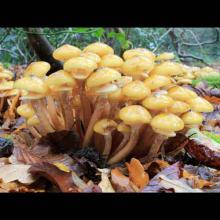Armillaria mellea
Common name:
Honey fungus
Genus:
Armillaria
Family:
Physalacriaceae
Order:
Agaricales
Armillaria mellea
Common name:
Honey fungus
Genus:
Armillaria
Family:
Physalacriaceae
Order:
Agaricales
Armillaria mellea
Common name:
Honey fungus
Genus:
Armillaria
Family:
Physalacriaceae
Order:
Agaricales
Genus (Fungi): Armillaria
Armillaria, is a genus of parasitic fungi that includes the A. mellea species known as honey fungi that live on trees and woody shrubs. It includes about 10 species formerly categorized summarily as A. mellea. Armillarias are long-lived and form some of the largest living organisms in the world. The largest known organism (of the species Armillaria ostoyae) covers more than 3.4 square miles (8.8 km2) in Oregon's Malheur National Forest and is more than 2,400 years old. Some species of Armillaria display bioluminescence, resulting in foxfire.
Armillaria can be a destructive forest pathogen. It causes "white rot" root disease (see Plant pathology section) of forests, which distinguishes it from Tricholoma, a mycorrhizal (non-parasitic) genus. Because Armillaria is a facultative saprophyte, it also feeds on dead plant material, allowing it to kill its host, unlike parasites that must moderate their growth to avoid host death.
In the Canadian Prairies (particularly Manitoba), Armillaria is referred to often as openky (Ukrainian: опеньки), meaning "near the stump" in Ukrainian.
Description
The basidiocarp (reproductive structure) of the fungus is a mushroom that grows on wood, typically in small dense clumps or tufts. Their caps (mushroom tops) are typically yellow-brown, somewhat sticky to touch when moist, and, depending on age, may range in shape from conical to convex to depressed in the center. The stipe (stalk) may or may not have a ring. All Armillaria species have a white spore print and none have a volva (cup at base).
Similar species include Pholiota spp. which also grow in cespitose (mat-like) clusters on wood and fruit in the fall. Pholiota spp. are separated from Armillaria by its yellowish to greenish-yellow tone and a dark brown to grey-brown spore print. Mushroom hunters need to be wary of Galerina spp. which can grow side-by-side with Armillaria spp. on wood. Galerina have a dark brown spore print and are deadly poisonous (alpha-amanitin).
Reference: Wikipedia

